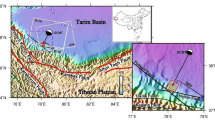Abstract
The island of Cephalonia (Western Greece), was struck by two strong seismic events, with magnitudes Mw = 6.0 and Mw = 5.9 which occurred on Jan. 26, 2014 and Feb. 3, 2014 respectively. The first event was located near Argostoli’s village, whereas the second one was located at the north part of Livadi village. These two strong seismic events were followed by smaller aftershocks provoking extensive crustal movements and structural damage effects. Differential Synthetic Aperture Radar Interferometry (DInSAR) is a powerful remote sensing tool for ground motion monitoring. Since the last two decades, DInSAR is widely used in a variety of applications including natural hazards such as earthquakes. In 2007, a high resolution X-band satellite namely TerraSAR-X was launched. Due to its short revisit cycle of 11 days and its short wavelength, it has a good potential to capture faster surface movements. This study refers to the application of the DInSAR using TerraSAR-X strip map data to monitor the co- and post-seismic surface deformation caused by the second seismic event. Using DInSAR methodology, three differential interferograms were calculated showing the displacement trend of the region, before and after the earthquake. Results demonstrate that the main part of the island shows stability to low uplift whereas in the western part a significant deformation pattern is observed. The findings permit a better understanding and identification of the local tectonic setting of the study area and the investigation of the reasons that some settlements were strongly affected by this seismic activity.





Similar content being viewed by others
References
Constantini M (1998) A novel phase unwrapping method based on network programming. IEEE T Geosci Remote S 36:813–821
Donnellan A, Parker G, Peltzer G (2002) Combined GPS and InSAR models of postseismic deformation from the Northridge earthquake. Pure Appl Geophys 159:2261–2270
Kiratzi AA, Langston CA (1991) Moment tensor inversion of the 1983 January 17 Kefallinia event of Ionian Islands (Greece). Geophys J Int 105(2):529–535. doi:10.1111/j.1365-246X.1991.tb06731.x
Kokinou E, Papadimitriou E, Karakostas V, Kamberis E, Vallianatos F (2006) The Cephalonia transform zone (offshore western Greece) with special emphasis to its prolongation towards the Ionian abyssal plain. Mar Geophys Res. doi:10.1007/s11001- 006-9005-2
Kyriakopoulos C, Chini M, Bignami C, Stramondo S, Ganas A, Kolligri M, Moshou A (2013) Monthly migration of a tectonic seismic swarm detected by DInSAR: southwest Peloponnese, Greece. Geophys J Int 197(3):1302–1309
Le Pichon X, Chamot-Rooke N, Lallemant S, Noomen R, Veis G (1995) Geodetic determination of the kinematics of Central Greece with respect to Europe: implications for Eastern Mediterranean tectonics. J Geophys Res 100(12):675–690
Liu W, Yamazaki F (2013) Detection of crustal movement from TerraSAR-X intensity image. IEEE Geosci Remote S 10(1):199–203
Massonnet D, Feigl KL (1998) Radar interferometry and its application to changes in the earth’s surface. Rev Geophys 36(4):441–500
Papadimitriou EE (1993) Focal mechanism along the convex side of the Hellenic Arc and its tectonic significance. Boll Geof Teor App 35:401–426
Papadopoulos GA, Karastathis VK, Koukouvelas I, Baskoutas I, Chouliaras G, Agalos G, Minadakis A, Mouzakiotis A, Sachpazi M, Daskalaki E, Moshou A, Orfanogiannaki K, Papageorgiou A, Spanos D (2014) Triantafyllou I (2014) The Cephalonia, Ionian Sea (Greece), sequence of strong earthquakes of January-February 2014: a first report. Res Geophys 4:5441
Pitz W, Miller D (2010) The TerraSAR-X Satellite. IEEE T Geosci Remote S 48(2):615–622
Prati C, Ferretti A, Perissin D (2010) Recent advances on surface deformation measurement by means of repeated space-borne SAR observations. J Geodyn 49:161–170
Scordilis EM, Karakaisis GF, Karakostas BG, Panagiotopoulos DG, Comninakis P, Papazachos BC (1985) Evidence for transform faulting in the Ionian Sea – the Cephalonia island earthquake sequence of 1983. Pure App Geophys 123(3):388–397. doi:10.1007/BF00880738
Stiros SC, Pirazzoli PA, Laborel J, Laborel-Deguen F (1994) The 1953 Earthquake in Cephalonia (Western Hellenic Arc): coastal uplift and halotectonic faulting. Geophys J Int 117:834–849
Stramondo S, Chini M, Bignami C, Salvi S, Atzori S (2009) X-, C-, and L-Band DInSAR Investigation of the April 6. Abruzzi Earthq IEEE Geosci Remote S 8(1):49–53
Strozzi T, Wegmuller U, Tosi L, Bitelli G, Spreckels V (2001) Land subsidence monitoring with differential SAR interferometry. Photogramm Eng Rem S 67(11):1261–1270
Tselentis GA, Melis NS, Sokos E, Beltas P (1997) The winter 1991–1992 earthquake sequence at Cephalonia Island, western Greece. Pure Appl Geophys 150:75–89
Valkaniotis S, Ganas A, Papathanassiou G, Papanikolaou M (2014) ield observations of geological effects triggered by the January-February 2014 cephalonia (Ionian Sea, Greece) earthquakes. Tectonophysics. doi:10.1016/j.tecto.2014.05.012
Wegmuller U, Werner C, Strozzi T. (1998) SAR interferometric and differential interferometric processing chain. International Geoscience and Remote Sensing Symposium (IGARSS), Seattle, WA, USA, 2: 1106–1108
Yague-Martinez N, Eineder M, Cong X, Minet C (2012) Ground displacement measurement by TerraSAR-X image correlation: the 2011 Tohoku-Oki earthquake. IEEE Geosci Remote S 9(4):539–543
Zebker HA, Rosen PA, Goldstein RM, Gabriel A, Werner CL (1994) On the derivation of coseismic displacement fields using differential radar interferometry: the Landers earthquake. J Geophys Res. doi:10.1029/94JB01179
Acknowledgments
Authors would like to thank Dr Christian Minet (DLR), Dr Michael Foumelis (ESA) and Dr Spyros Lalechos (EPPO) for their support in order to accelerate the procedure to obtained scenes over the island. DLR for the provision of the TerraSAR-X data, © DLR 2014.
Author information
Authors and Affiliations
Corresponding author
Additional information
Communicated by: K. Nikolakopoulus
Published in the Special Issue of Remote Sensing and Geology “Surveying the GEOsphere”, with Guest Editors Dr. Konstantinos Nikolakopoulus, Dr. Cornelia Glaesser and Dr. Nilanchal Patel
Rights and permissions
About this article
Cite this article
Benekos, G., Derdelakos, K., Bountzouklis, C. et al. Surface displacements of the 2014 Cephalonia (Greece) earthquake using high resolution SAR interferometry. Earth Sci Inform 8, 309–315 (2015). https://doi.org/10.1007/s12145-015-0205-7
Received:
Accepted:
Published:
Issue Date:
DOI: https://doi.org/10.1007/s12145-015-0205-7




